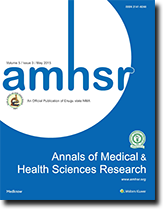

Background: In the context of Covid-19 infections, acute Olfactory Dysfunction (OD) is defined as decreased or altered s.. Read more
Abstract PDFBackground: Rivaroxaban, an oral thing Xa inhibitor, is effective in treating venous thromboembolism, and has been shown.. Read more
Abstract PDFBackground: Nasogastric decompression the usage of a Nasogastric Tube (NGT) has been robotically executed after intestin.. Read more
Abstract PDFBackground: The development of minimally invasive strategies, together with MicroOsteoperforations (MOPs), has made impr.. Read more
Abstract PDFBackground: The loop approach is an alternative to packing that does not require large incisions can be used in both sma.. Read more
Abstract PDFBackground: Gestational Diabetes Mellitus (GDM), a common obstetric complication, is defined as any degree of glucose in.. Read more
Abstract PDFTo determine the relationship of gingival pigmentation of different passive smoker age groups (both genders) with active household smoker.. Read more
Abstract PDFPurpose: This study performed an effect-size analysis of instrument assisted soft tissue mobilization for increase range.. Read more
Abstract PDFIntroduction: Androgenetic alopecia is the most frequent cause of hair loss worldwide, affecting around 70% of males and.. Read more
Abstract PDFBackground: Good glycemic control significantly reduces the incidence of diabetesrelated complications; however, it depe.. Read more
Abstract PDF1-Methyl-4-(6-(subsitutedphenyl)-(1,2,4)triazolo(3,4-b)(1,3,4)thiadiazol-3-yl)- alkylpyridinium was synthesized in this study. The 4-Amin.. Read more
Abstract PDFThe aim of the study was to evaluate the effect of local blood substitute rheomannisol on some metabolic, functional and structural param.. Read more
Abstract PDFThe ginger plant (Zingiber Officinale Roscoe) has been widely used by the community as a kitchen spice, as alternative medici.. Read more
Abstract PDFBackground: Female genital mutilation is not without consequences, varying according to the type and severity includes c.. Read more
Abstract PDFBackground: Hyperhidrosis, meaning excessive sweating, can be described as perspiration in excess of the physiologic amo.. Read more
Abstract PDFPancreatic cancer is becoming the second leading cause of cancer deaths, mainly attributed to late diagnosis. Surgical resection remains .. Read more
Abstract PDFThis paper is for the purpose of the hematological parameters as regards Hepatitis B-negative donors in the University Teaching Hospit.. Read more
Abstract PDF
Abstracting and Indexing Information
The journal is registered with the following abstracting partners:
Baidu Scholar, CNKI (China National Knowledge Infrastructure), EBSCO Publishing's Electronic Databases, Exlibris – Primo Central, Google Scholar, Hinari, Infotrieve, National Science Library, ProQuest, TdNet, African Index Medicus
The journal is indexed with, or included in, the following:
Emerging Sources Citation Index, Index Copernicus, PubMed Central
Select your language of interest to view the total content in your interested language
Annals of Medical and Health Sciences Research received 24805 citations as per google scholar report
 The Annals of Medical and Health Sciences Research is a monthly multidisciplinary medical journal.
The Annals of Medical and Health Sciences Research is a monthly multidisciplinary medical journal.